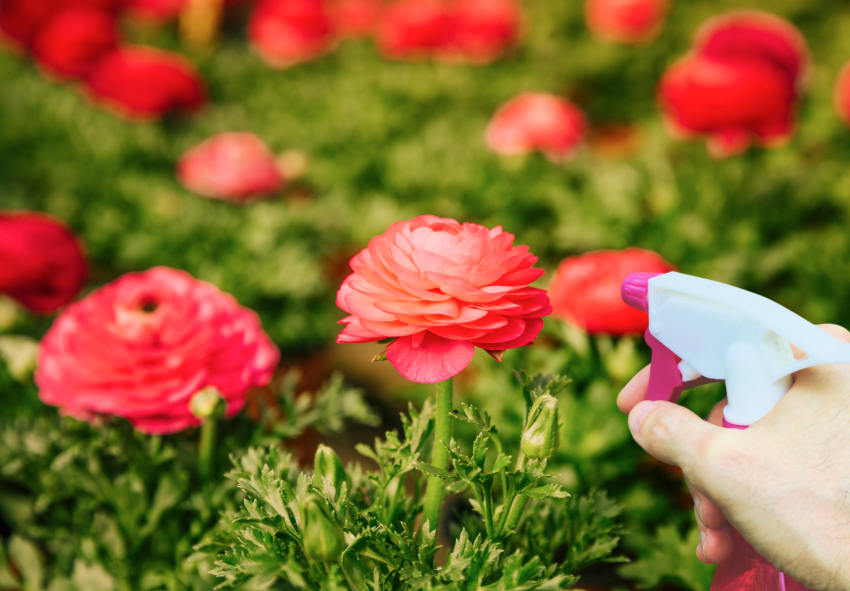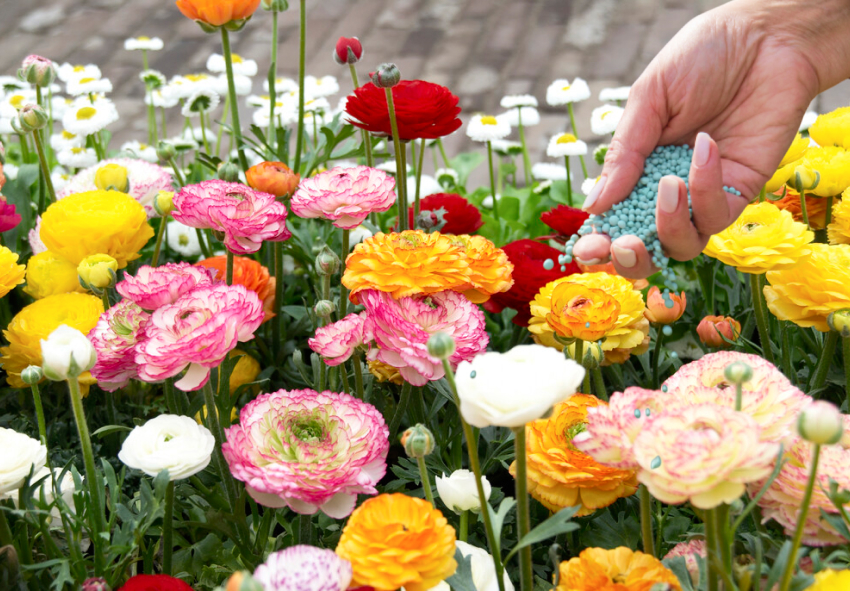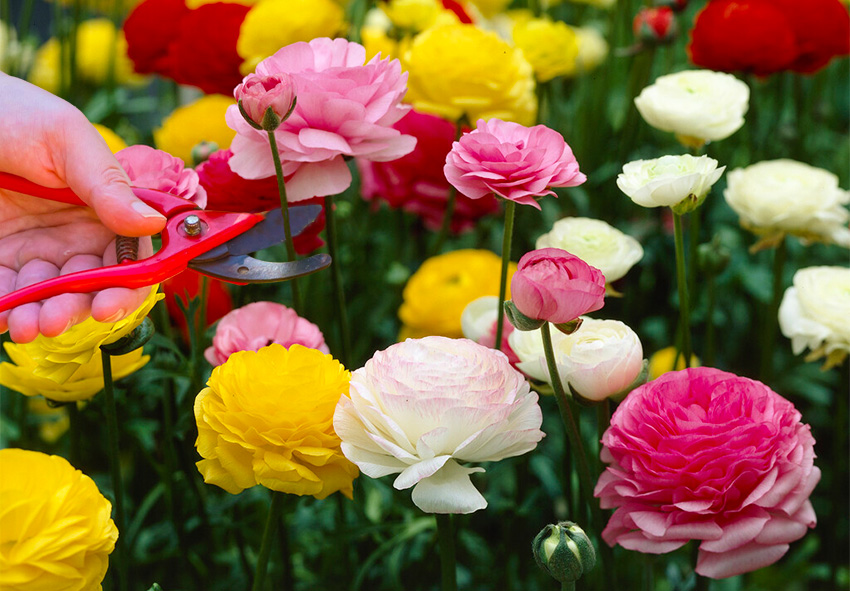Ranunculus asiaticus, known for its layered, rose-like blooms, is a favorite among gardeners for spring and early summer displays. While planting is just the beginning, proper care after planting is what ensures vibrant, healthy flowers. This guide will walk you through all aspects of Ranunculus maintenance to help you get the most out of your blooms. Our gardening blog is a perfect place to find all the information you need!
Understanding Ranunculus asiaticus Growth Cycle

To care for Ranunculus successfully, it’s important to understand how the plant develops after planting. From dormancy to active growth and blooming, each stage requires different care strategies. Knowing this cycle helps you provide what the plant needs at the right time.
Dormancy and Sprouting Phase
Ranunculus tubers start in a dormant state and require time to establish themselves in the soil before showing visible signs of growth. During this phase, the tubers absorb moisture and begin root development. It’s important to maintain slightly moist soil and avoid disturbance while waiting for the first green shoots to appear.
Active Growing Season
Once sprouted, Ranunculus enters a rapid growth phase, producing lush foliage and flower buds. This active season usually spans late winter to spring, depending on planting time and climate. Providing consistent care during this period is essential for strong stems and multiple blooms.
Watering Ranunculus After Planting
Proper watering is one of the most critical elements of post-planting care. Too much or too little water can both harm young tubers and hinder growth. This section outlines how to create a watering routine that supports healthy development without risking rot.
Initial Watering Needs
Watering is crucial right after planting, but overwatering can lead to rot. Lightly water the soil to initiate hydration, ensuring it remains moist but not soggy. In cold or damp climates, hold off on heavy watering until visible growth appears.
Watering During Growth
As Ranunculus begins to grow, consistent watering is key. Use a deep but infrequent watering routine to encourage strong root development. Following a balanced Ranunculus asiaticus watering guide prevents both dehydration and fungal issues.
Light and Temperature Requirements
Ranunculus asiaticus thrives under specific light and temperature conditions. Giving your plants the right amount of sunlight and protecting them from extreme temperatures will ensure strong stems and vibrant blooms. Understanding these needs is key to long-term success.
- Optimal Sunlight Conditions
Ranunculus thrives in full sun, needing at least 6 hours of direct light per day. Adequate sunlight supports strong, upright growth and maximizes bloom production. In hot regions, partial shade during the hottest hours can help prevent wilting.
- Temperature Sensitivity
Ranunculus asiaticus prefers cool to mild temperatures, ideally between 50–70°F (10–21°C). Extreme cold or frost can damage new shoots, so protection with row covers or frost cloth is recommended in early spring. Avoid planting outdoors too early in colder climates.
Fertilizing and Soil Nutrients

Like all flowering plants, Ranunculus needs nutrient-rich soil and timely feeding to perform well. Fertilization helps boost root development and flower production when applied correctly. Here, we’ll explore when and how to nourish your plants for the best results.
When to Start Fertilizing
Begin fertilizing once shoots are a few inches tall to support active growth. Apply a balanced fertilizer every 2–3 weeks during the blooming phase. Following basic Ranunculus fertilizing tips can significantly improve flower size and longevity.
Soil Composition and Drainage
Healthy soil is the foundation of successful Ranunculus asiaticus care. These plants need loose, well-draining soil to prevent rot and encourage strong root development. Improving your soil before planting can greatly increase your chances of vigorous growth and abundant blooms.
Key Tips for Ideal Soil Conditions:
- Use sandy or loamy soil – Promotes excellent drainage and root spread.
- Add compost or aged organic matter – Boosts nutrients and soil texture.
- Avoid heavy clay soil – It retains too much water and can suffocate tubers.
- Amend with perlite or coarse sand if needed – Enhances drainage in compact soils.
- Ensure raised beds or containers have drainage holes – Prevents water buildup around roots.
Mulching and Moisture Retention
Applying mulch helps maintain even soil moisture and suppresses weeds. Organic mulches like straw or compost also improve soil structure as they decompose. Keep mulch a few inches away from stems to reduce the risk of rot.
Supporting Healthy Blooms
Once your Ranunculus begins to flower, ongoing care can keep it blooming longer and more vigorously. Maintenance practices like deadheading and pest control are important for overall plant health. Learn how to support your blooms so they stay beautiful throughout the season.
Deadheading and Flower Maintenance
Removing spent flowers, or deadheading, encourages the plant to produce more blooms. This simple task also keeps the plant looking tidy and reduces the risk of disease. Use clean, sharp scissors or pruners for best results.
Managing Pests and Diseases
Ranunculus can be affected by aphids, powdery mildew, and root rot if conditions are poor. Inspect plants weekly and use neem oil or insecticidal soap as organic treatments. Good air circulation and dry foliage help prevent most fungal issues. Find more useful information in our full guide for Ranunculus Asiaticus.
What to Do After Blooming Ends

Caring for Ranunculus doesn’t stop when the flowers fade. The post-bloom period is essential for preparing the tubers for future seasons. This section explains how to handle foliage, lift tubers, and store them properly to ensure repeat success.
Letting the Foliage Die Back Naturally
Allowing foliage to wither naturally helps the tubers store energy for the next season. This process typically takes several weeks after flowering has stopped. Avoid cutting leaves back too early, as it can weaken future growth.
Lifting and Storing Ranunculus Tubers
Once the foliage has fully died back, dig up the tubers gently and brush off excess soil. Store them in a cool, dry, and dark place—ideally in a paper bag or box with peat moss or vermiculite. Proper storage ensures the tubers remain viable for the next planting season.
Common Mistakes to Avoid
Even experienced gardeners can run into trouble when growing Ranunculus if a few basic care principles are overlooked. Avoiding these common mistakes can make the difference between a disappointing season and a thriving, flower-filled display. Here are the most frequent pitfalls to watch out for:
- Overwatering Tubers After Planting: Excess moisture can cause tubers to rot before they sprout. Always ensure soil is moist but never soggy, especially during the early establishment phase.
- Planting Too Deep or Too Shallow: Tubers planted too deep may rot, while those too shallow risk drying out or failing to anchor properly. Aim for 2 inches deep with the claw side facing down.
- Using Poorly Drained Soil: Ranunculus dislikes heavy, compacted soil that retains water. Ensure good drainage by mixing in sand or compost if needed.
- Fertilizing Too Early or Too Often: Applying fertilizer before sprouting can waste nutrients or even burn developing roots. Begin fertilizing only once the shoots are established.
- Neglecting Pest and Disease Monitoring: Aphids, mildew, and root rot can quietly spread without regular inspection. Keep a close eye on your plants weekly to catch problems early.
Final Tips for Long-Term Ranunculus Success
Start with healthy tubers and plant at the right time for your climate. Consistent care—especially proper watering, feeding, and sunlight—will lead to long-lasting blooms. Rotate planting spots each year to avoid soil-borne issues and improve future performance.
Frequently Asked Questions (FAQs) about Care for Ranunculus
1. How often should I water Ranunculus after planting?
Water lightly after planting, just enough to moisten the soil. Once shoots appear, water regularly—about once or twice a week—ensuring the soil stays moist but not soggy. Always let the top inch of soil dry out slightly between waterings to avoid rot. In hotter climates or containers, you may need to adjust frequency.
2. Can I order Holland Ranunculus asiaticus from your online store?
Yes, in our online store Dutch-bulbs.com we offer a wide selection of Ranunculus asiaticus, including some varieties originating from Holland, renowned for their quality and beauty. Explore our collection to find the perfect Ranunculus asiaticus varieties for your garden or landscaping projects.
3. What should I do when Ranunculus stops blooming?
After blooming, allow the foliage to die back naturally so the tubers can store energy. Once the leaves turn yellow and dry, dig up the tubers if you’re in a cold climate. Let them dry, then store in a cool, dark, and dry place to replant next season.
4. Do Ranunculus asiaticus come back every year?
Ranunculus is a tender perennial, meaning it can return yearly in mild climates (zones 8–10). In colder areas, the tubers must be lifted and stored over winter to prevent frost damage. With proper storage and care, they can be replanted for blooms in the following season.
5. Why are my Ranunculus leaves turning yellow?
Yellowing leaves can indicate overwatering, poor drainage, or natural dieback after blooming. Check soil moisture first—soggy soil can suffocate roots. If the plant has finished flowering, yellowing may be a normal part of the plant’s life cycle as it enters dormancy.
Published: 06.05.2025
